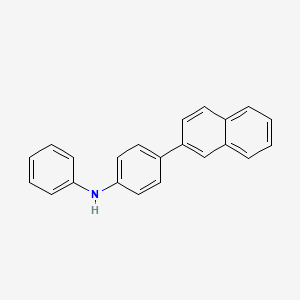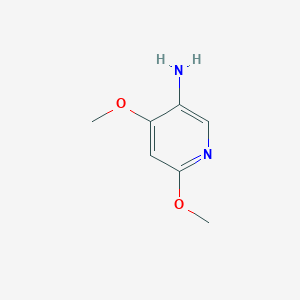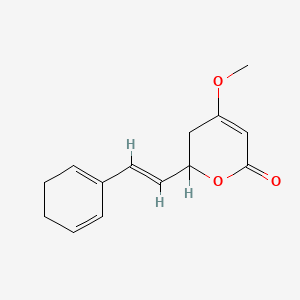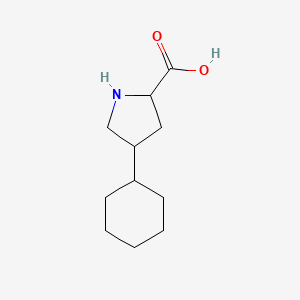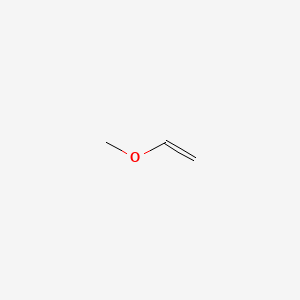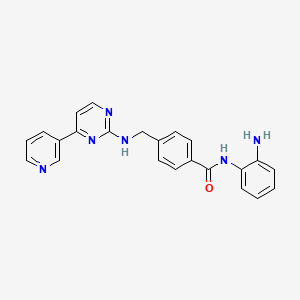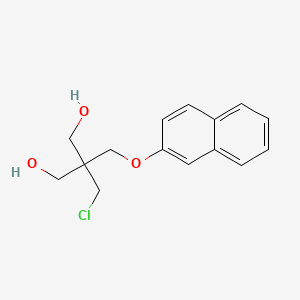
Semaglutide
Overview
Description
Semaglutide is a glucagon-like peptide 1 receptor agonist used to improve glycemic control in type 2 diabetes mellitus, treat obesity, and reduce the risk of major adverse cardiovascular events in selected adults . It is a synthetic analog of the human glucagon-like peptide 1 hormone, which plays a crucial role in glucose metabolism .
Scientific Research Applications
Semaglutide has a wide range of scientific research applications. In medicine, it is used to manage type 2 diabetes and obesity . It has shown potential in treating non-alcoholic steatohepatitis and neurodegenerative diseases such as Parkinson’s and Alzheimer’s . In biology, this compound is used to study the effects of glucagon-like peptide 1 receptor agonists on glucose metabolism and insulin secretion . In industry, it is used in the development of long-acting injectable formulations for sustained drug release .
Mechanism of Action
Semaglutide, also known as Ozempic, is a glucagon-like peptide-1 (GLP-1) receptor agonist used in the treatment of type 2 diabetes and obesity . This article will delve into the mechanism of action, biochemical pathways, pharmacokinetics, and the effects of environmental factors on this compound.
Target of Action
This compound primarily targets the glucagon-like peptide-1 (GLP-1) receptors . These receptors are found in various parts of the body, including the pancreas and the brain . They play a crucial role in regulating blood sugar levels and influencing appetite .
Mode of Action
This compound binds to and activates the GLP-1 receptors, thereby stimulating insulin secretion and reducing blood glucose . This interaction is glucose-dependent, meaning it occurs when blood sugar levels are high . This compound also slows down the digestive process, prolonging the feeling of fullness .
Biochemical Pathways
This compound affects several biochemical pathways. By binding to the GLP-1 receptors, it stimulates the release of insulin, a hormone that helps cells absorb glucose from the bloodstream . This leads to a decrease in blood sugar levels . This compound also inhibits the release of glucagon, a hormone that raises blood glucose levels .
Pharmacokinetics
This compound has a predictable pharmacokinetic profile with a long half-life of 7 days, allowing for once-weekly subcutaneous administration . It is slowly and extensively metabolized, with about 83% of the administered dose measured in the plasma as unchanged drug . This compound is metabolized via proteolytic cleavage of the peptide backbone and sequential β-oxidation of the fatty acid chain, with no single organ acting as the major route of elimination .
Action Environment
Environmental factors such as diet, exercise, and sleep patterns can influence the action of this compound . Psychological factors like stress and emotional eating can interfere with the appetite-suppressing effects of this compound . Moreover, food and various dosing conditions including water volume and dosing schedules can affect the oral this compound exposure .
Safety and Hazards
Future Directions
Semaglutide has an overall favorable risk/benefit profile for patients with type 2 diabetes . The evolution of the GLP-1RA class to include an oral agent could facilitate the use of these agents earlier in the diabetes treatment cascade . Further rigorous studies are still urgently required to develop practice guidelines as innovative drugs become commercially available .
Biochemical Analysis
Biochemical Properties
Semaglutide is characterized by a sequence that closely resembles that of GLP-1 but with strategic modifications to improve its stability and efficacy . These modifications include the substitution of alanine with α-aminoisobutyric acid at position 8, which provides resistance to DPP-4-mediated cleavage . Additionally, the attachment of a C-18 fatty diacid to lysine at position 26 via a spacer molecule appears to extend the peptide’s half-life by promoting albumin binding .
Cellular Effects
This compound may play a critical role in modulating glucose homeostasis. It is hypothesized to enhance insulin secretion from pancreatic beta cells in response to enhanced blood glucose levels . This action is believed to be mediated through GLP-1 receptors, which are widely distributed in pancreatic islets . By potentiating glucose-dependent insulin secretion, this compound might aid in maintaining optimal blood glucose levels . Moreover, research indicates that this compound might inhibit glucagon secretion from alpha cells of the pancreas .
Molecular Mechanism
This compound is a glucagon-like peptide-1 receptor agonist . The decrease in blood sugar levels is theorized to be caused by the mimicking of the incretin glucagon-like peptide-1 (GLP-1) . It enhances insulin secretion and inhibits glucagon secretion in a glucose-dependent manner .
Temporal Effects in Laboratory Settings
Long-term oral this compound with flexible dose adjustment maintained HbA1c reductions, with additional body weight reductions, and was well tolerated . The effect of pepsin on oral this compound stability was most profound at low pH, with oral this compound being most labile toward pepsin at pH 2.6 (t½ = 16 min). In contrast, increasing the pH to 5.0 extended the t ½ of oral this compound to 34 minutes, and at neutral pH, oral this compound was almost entirely stabilized ( t ½ >100 min) .
Dosage Effects in Animal Models
This compound significantly reduced body weight in obese mice as well as exerted anti-inflammatory and antioxidant effects possibly by inhibiting the expression of S100a8, S100a9, and Cxcl2 in neutrophils . A study conducted on rats and mice over a 2-year period showed that this compound administration “at clinically relevant exposures” is associated with thyroid C-cell tumors .
Metabolic Pathways
This compound is a GLP-1 analog that has been shown to significantly improve glycemic control and reduce body weight, in addition to improving cardiovascular outcomes, in patients with T2D . It is involved in the regulation of glucose homeostasis and insulin signaling pathways .
Transport and Distribution
This compound is mainly distributed within the plasma volume, with a plasma protein binding of > 99% . It is extensively metabolised before excretion via urine and faeces .
Preparation Methods
Semaglutide is synthesized through a convergent synthetic strategy. The process involves coupling amino acids to a solid-phase resin step by step, followed by cleavage and purification to obtain the final product . Industrial production methods include the use of liquid-phase and solid-phase synthesis techniques to ensure high purity and yield . The preparation of this compound long-acting injectable microcapsules involves a double emulsion process to achieve sustained release and improved stability .
Chemical Reactions Analysis
Semaglutide undergoes various chemical reactions, including oxidation, reduction, and substitution . Common reagents used in these reactions include trifluoroacetic acid, formic acid, and acetonitrile . Major products formed from these reactions include the peptide itself and its modified forms, which are analyzed using high-performance liquid chromatography and mass spectrometry .
Comparison with Similar Compounds
Semaglutide is similar to other glucagon-like peptide 1 receptor agonists such as exenatide and liraglutide . it offers a competitive advantage due to its longer half-life and once-weekly dosing regimen . Unlike exenatide and liraglutide, this compound is available in both subcutaneous and oral formulations . Other similar compounds include tirzepatide, which mimics both glucagon-like peptide 1 and glucose-dependent insulinotropic polypeptide .
Properties
IUPAC Name |
18-[[(1R)-4-[2-[2-[2-[2-[2-[2-[[(5S)-5-[[(2S)-2-[[(2S)-2-[[(2S)-5-amino-2-[[2-[[(2S)-2-[[(2S)-2-[[(2S)-2-[[(2S)-2-[[(2S)-2-[[(2S)-2-[[(2S)-2-[[(2S)-2-[[(2S,3R)-2-[[(2S)-2-[[(2S,3R)-2-[[2-[[(2S)-2-[[2-[[(2S)-2-amino-3-(1H-imidazol-5-yl)propanoyl]amino]-2-methylpropanoyl]amino]-4-carboxybutanoyl]amino]acetyl]amino]-3-hydroxybutanoyl]amino]-3-phenylpropanoyl]amino]-3-hydroxybutanoyl]amino]-3-hydroxypropanoyl]amino]-3-carboxypropanoyl]amino]-3-methylbutanoyl]amino]-3-hydroxypropanoyl]amino]-3-hydroxypropanoyl]amino]-3-(4-hydroxyphenyl)propanoyl]amino]-4-methylpentanoyl]amino]-4-carboxybutanoyl]amino]acetyl]amino]-5-oxopentanoyl]amino]propanoyl]amino]propanoyl]amino]-6-[[(2S)-1-[[(2S)-1-[[(2S,3S)-1-[[(2S)-1-[[(2S)-1-[[(2S)-1-[[(2S)-1-[[(2S)-5-carbamimidamido-1-[[2-[[(2S)-5-carbamimidamido-1-(carboxymethylamino)-1-oxopentan-2-yl]amino]-2-oxoethyl]amino]-1-oxopentan-2-yl]amino]-3-methyl-1-oxobutan-2-yl]amino]-4-methyl-1-oxopentan-2-yl]amino]-3-(1H-indol-3-yl)-1-oxopropan-2-yl]amino]-1-oxopropan-2-yl]amino]-3-methyl-1-oxopentan-2-yl]amino]-1-oxo-3-phenylpropan-2-yl]amino]-4-carboxy-1-oxobutan-2-yl]amino]-6-oxohexyl]amino]-2-oxoethoxy]ethoxy]ethylamino]-2-oxoethoxy]ethoxy]ethylamino]-1-carboxy-4-oxobutyl]amino]-18-oxooctadecanoic acid | |
|---|---|---|
| Details | Computed by Lexichem TK 2.7.0 (PubChem release 2021.05.07) | |
| Source | PubChem | |
| URL | https://pubchem.ncbi.nlm.nih.gov | |
| Description | Data deposited in or computed by PubChem | |
InChI |
InChI=1S/C187H291N45O59/c1-18-105(10)154(180(282)208-108(13)159(261)216-133(86-114-89-200-119-50-40-39-49-117(114)119)170(272)218-129(82-102(4)5)171(273)228-152(103(6)7)178(280)215-121(53-44-72-199-186(192)193)162(264)201-91-141(242)209-120(52-43-71-198-185(190)191)161(263)204-94-151(257)258)230-172(274)131(83-111-45-33-31-34-46-111)219-167(269)126(64-69-149(253)254)214-166(268)122(51-41-42-70-195-144(245)98-290-79-78-289-76-74-197-145(246)99-291-80-77-288-75-73-196-139(240)66-61-127(183(285)286)211-140(241)54-37-29-27-25-23-21-19-20-22-24-26-28-30-38-55-146(247)248)212-158(260)107(12)206-157(259)106(11)207-165(267)125(60-65-138(189)239)210-142(243)92-202-163(265)123(62-67-147(249)250)213-168(270)128(81-101(2)3)217-169(271)130(85-113-56-58-116(238)59-57-113)220-175(277)135(95-233)223-177(279)137(97-235)224-179(281)153(104(8)9)229-174(276)134(88-150(255)256)221-176(278)136(96-234)225-182(284)156(110(15)237)231-173(275)132(84-112-47-35-32-36-48-112)222-181(283)155(109(14)236)227-143(244)93-203-164(266)124(63-68-148(251)252)226-184(287)187(16,17)232-160(262)118(188)87-115-90-194-100-205-115/h31-36,39-40,45-50,56-59,89-90,100-110,118,120-137,152-156,200,233-238H,18-30,37-38,41-44,51-55,60-88,91-99,188H2,1-17H3,(H2,189,239)(H,194,205)(H,195,245)(H,196,240)(H,197,246)(H,201,264)(H,202,265)(H,203,266)(H,204,263)(H,206,259)(H,207,267)(H,208,282)(H,209,242)(H,210,243)(H,211,241)(H,212,260)(H,213,270)(H,214,268)(H,215,280)(H,216,261)(H,217,271)(H,218,272)(H,219,269)(H,220,277)(H,221,278)(H,222,283)(H,223,279)(H,224,281)(H,225,284)(H,226,287)(H,227,244)(H,228,273)(H,229,276)(H,230,274)(H,231,275)(H,232,262)(H,247,248)(H,249,250)(H,251,252)(H,253,254)(H,255,256)(H,257,258)(H,285,286)(H4,190,191,198)(H4,192,193,199)/t105-,106-,107-,108-,109+,110+,118-,120-,121-,122-,123-,124-,125-,126-,127+,128-,129-,130-,131-,132-,133-,134-,135-,136-,137-,152-,153-,154-,155-,156-/m0/s1 | |
| Details | Computed by InChI 1.0.6 (PubChem release 2021.05.07) | |
| Source | PubChem | |
| URL | https://pubchem.ncbi.nlm.nih.gov | |
| Description | Data deposited in or computed by PubChem | |
InChI Key |
DLSWIYLPEUIQAV-CCUURXOWSA-N | |
| Details | Computed by InChI 1.0.6 (PubChem release 2021.05.07) | |
| Source | PubChem | |
| URL | https://pubchem.ncbi.nlm.nih.gov | |
| Description | Data deposited in or computed by PubChem | |
Canonical SMILES |
CCC(C)C(C(=O)NC(C)C(=O)NC(CC1=CNC2=CC=CC=C21)C(=O)NC(CC(C)C)C(=O)NC(C(C)C)C(=O)NC(CCCNC(=N)N)C(=O)NCC(=O)NC(CCCNC(=N)N)C(=O)NCC(=O)O)NC(=O)C(CC3=CC=CC=C3)NC(=O)C(CCC(=O)O)NC(=O)C(CCCCNC(=O)COCCOCCNC(=O)COCCOCCNC(=O)CCC(C(=O)O)NC(=O)CCCCCCCCCCCCCCCCC(=O)O)NC(=O)C(C)NC(=O)C(C)NC(=O)C(CCC(=O)N)NC(=O)CNC(=O)C(CCC(=O)O)NC(=O)C(CC(C)C)NC(=O)C(CC4=CC=C(C=C4)O)NC(=O)C(CO)NC(=O)C(CO)NC(=O)C(C(C)C)NC(=O)C(CC(=O)O)NC(=O)C(CO)NC(=O)C(C(C)O)NC(=O)C(CC5=CC=CC=C5)NC(=O)C(C(C)O)NC(=O)CNC(=O)C(CCC(=O)O)NC(=O)C(C)(C)NC(=O)C(CC6=CN=CN6)N | |
| Details | Computed by OEChem 2.3.0 (PubChem release 2021.05.07) | |
| Source | PubChem | |
| URL | https://pubchem.ncbi.nlm.nih.gov | |
| Description | Data deposited in or computed by PubChem | |
Isomeric SMILES |
CC[C@H](C)[C@@H](C(=O)N[C@@H](C)C(=O)N[C@@H](CC1=CNC2=CC=CC=C21)C(=O)N[C@@H](CC(C)C)C(=O)N[C@@H](C(C)C)C(=O)N[C@@H](CCCNC(=N)N)C(=O)NCC(=O)N[C@@H](CCCNC(=N)N)C(=O)NCC(=O)O)NC(=O)[C@H](CC3=CC=CC=C3)NC(=O)[C@H](CCC(=O)O)NC(=O)[C@H](CCCCNC(=O)COCCOCCNC(=O)COCCOCCNC(=O)CC[C@H](C(=O)O)NC(=O)CCCCCCCCCCCCCCCCC(=O)O)NC(=O)[C@H](C)NC(=O)[C@H](C)NC(=O)[C@H](CCC(=O)N)NC(=O)CNC(=O)[C@H](CCC(=O)O)NC(=O)[C@H](CC(C)C)NC(=O)[C@H](CC4=CC=C(C=C4)O)NC(=O)[C@H](CO)NC(=O)[C@H](CO)NC(=O)[C@H](C(C)C)NC(=O)[C@H](CC(=O)O)NC(=O)[C@H](CO)NC(=O)[C@H]([C@@H](C)O)NC(=O)[C@H](CC5=CC=CC=C5)NC(=O)[C@H]([C@@H](C)O)NC(=O)CNC(=O)[C@H](CCC(=O)O)NC(=O)C(C)(C)NC(=O)[C@H](CC6=CN=CN6)N | |
| Details | Computed by OEChem 2.3.0 (PubChem release 2021.05.07) | |
| Source | PubChem | |
| URL | https://pubchem.ncbi.nlm.nih.gov | |
| Description | Data deposited in or computed by PubChem | |
Molecular Formula |
C187H291N45O59 | |
| Details | Computed by PubChem 2.1 (PubChem release 2021.05.07) | |
| Source | PubChem | |
| URL | https://pubchem.ncbi.nlm.nih.gov | |
| Description | Data deposited in or computed by PubChem | |
Molecular Weight |
4114 g/mol | |
| Details | Computed by PubChem 2.1 (PubChem release 2021.05.07) | |
| Source | PubChem | |
| URL | https://pubchem.ncbi.nlm.nih.gov | |
| Description | Data deposited in or computed by PubChem | |
CAS No. |
910463-68-2 | |
| Record name | Semaglutide [USAN:INN] | |
| Source | ChemIDplus | |
| URL | https://pubchem.ncbi.nlm.nih.gov/substance/?source=chemidplus&sourceid=0910463682 | |
| Description | ChemIDplus is a free, web search system that provides access to the structure and nomenclature authority files used for the identification of chemical substances cited in National Library of Medicine (NLM) databases, including the TOXNET system. | |
| Record name | Semaglutide18-[[(1R)-4-[2-[2-[2-[2-[2-[2-[[(5S)-5-[[(2S)-2-[[(2S)-2-[[(2S)-5-amino-2-[[2-[[(2S)-2-[[(2S)-2-[[(2S)-2-[[(2S)-2-[[(2S)-2-[[(2S)-2-[[(2S)-2-[[(2S)-2-[[(2S,3R)-2-[[(2S)-2-[[(2S,3R)-2-[[2-[[(2S)-2-[[2-[[(2S)-2-amino-3-(1Himidazol-5-yl)propanoyl]amino]-2-methylpropanoyl]amino]-4 carboxybutanoyl]amino]acetyl]amino]-3-hydroxybutanoyl]amino]-3-phenylpropanoyl]amino]-3-hydroxybutanoyl]amino]-3-hydroxypropanoyl]amino]-3-carboxypropanoyl]amino]-3-methylbutanoyl]amino]-3-hydroxypropanoyl]amino]-3-hydroxypropanoyl]amino]-3-(4-hydroxyphenyl)propanoyl]amino]-4-methylpentanoyl]amino]-4 carboxybutanoyl]amino]acetyl]amino]-5 oxopentanoyl]amino]propanoyl]amino]propanoyl]amino]-6-[[(2S)-1-[[(2S)-1-[[(2S,3S)-1-[[(2S)-1-[[(2S)-1-[[(2S)-1-[[(2S)-1-[[(2S)-5-carbamimidamido-1-[[2-[[(2S)-5-carbamimidamido-1-(carboxymethylamino)-1-oxopentan-2-yl]amino]-2-oxoethyl]amino]-1-oxopentan-2-yl]amino]-3-methyl-1-oxobutan-2-yl]amino]-4-methyl-1-oxopentan-2-yl]amino]-3-(1H-indol-3-yl)-1-oxopropan-2-yl]amino]-1-oxopropan-2-yl]amino]-3-methyl-1-oxopentan-2-yl]amino]-1-oxo-3-phenylpropan-2-yl]amino]-4-carboxy-1-oxobutan-2-yl]amino]-6-oxohexyl]amino]-2-oxoethoxy]ethoxy]ethylamino]-2-oxoethoxy]ethoxy]ethylamino]-1-carboxy-4-oxobutyl]amino]-18-oxooctadecanoic acid | |
| Source | European Chemicals Agency (ECHA) | |
| URL | https://echa.europa.eu/information-on-chemicals | |
| Description | The European Chemicals Agency (ECHA) is an agency of the European Union which is the driving force among regulatory authorities in implementing the EU's groundbreaking chemicals legislation for the benefit of human health and the environment as well as for innovation and competitiveness. | |
| Explanation | Use of the information, documents and data from the ECHA website is subject to the terms and conditions of this Legal Notice, and subject to other binding limitations provided for under applicable law, the information, documents and data made available on the ECHA website may be reproduced, distributed and/or used, totally or in part, for non-commercial purposes provided that ECHA is acknowledged as the source: "Source: European Chemicals Agency, http://echa.europa.eu/". Such acknowledgement must be included in each copy of the material. ECHA permits and encourages organisations and individuals to create links to the ECHA website under the following cumulative conditions: Links can only be made to webpages that provide a link to the Legal Notice page. | |
Disclaimer and Information on In-Vitro Research Products
Please be aware that all articles and product information presented on BenchChem are intended solely for informational purposes. The products available for purchase on BenchChem are specifically designed for in-vitro studies, which are conducted outside of living organisms. In-vitro studies, derived from the Latin term "in glass," involve experiments performed in controlled laboratory settings using cells or tissues. It is important to note that these products are not categorized as medicines or drugs, and they have not received approval from the FDA for the prevention, treatment, or cure of any medical condition, ailment, or disease. We must emphasize that any form of bodily introduction of these products into humans or animals is strictly prohibited by law. It is essential to adhere to these guidelines to ensure compliance with legal and ethical standards in research and experimentation.


![6-Chloro-1-(phenylsulfonyl)-1H-pyrrolo[2,3-b]pyridine](/img/structure/B3030384.png)


